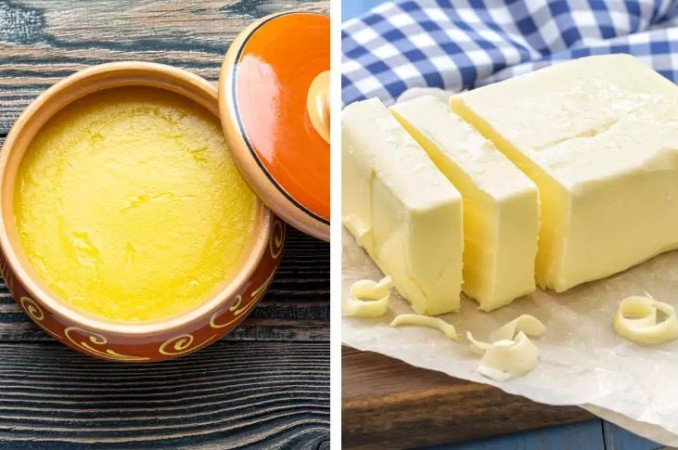
The traditional use of ghee (clarified butter) and butter in Indian households spans centuries, with a particular emphasis in Northern India due to cultural and taste preferences. These dairy products are not only cherished for their rich flavor but also for their potential health benefits. Both ghee and butter contain saturated fats, and when consumed in moderation, they can play a role in hormone production and cell formation. However, the recommendations surrounding their intake vary, especially for individuals dealing with weight issues or high cholesterol. As the winter season approaches, many individuals incorporate these dairy products into their diets, believing them to provide warmth and energy. Preferences among the younger generation also play a role, with some favoring ghee over butter and vice versa. In this article, we will delve into the expert opinions on the health aspects of ghee and butter, exploring their nutritional content, benefits, and potential drawbacks.
Nutritional Content and Benefits:
Ghee, a staple in Indian cooking, is known for its rich flavor and versatility. Experts highlight that ghee, like butter, contains saturated fats, which have been subject to varying opinions in the field of nutrition. While excessive consumption of saturated fats has been associated with cardiovascular issues, it is essential to recognize that not all saturated fats are created equal. Ghee, being a source of saturated fats, also contains healthy fats that can contribute positively to overall health.
The solid components found in butter, which include milk solids and water, differentiate it from ghee. Ghee, in contrast, is primarily composed of pure fat after the milk solids are removed during the clarifying process. This characteristic makes ghee more suitable for those with lactose intolerance or individuals seeking a dairy product with reduced solid components.
Comparative Analysis: Ghee vs. Butter:
One significant aspect of the ghee vs. butter debate is the smoking point, a crucial factor in cooking. Ghee, with its higher smoking point, becomes an ideal choice for high-temperature cooking. This makes it particularly advantageous for Indian cuisine, which often involves sautéing and deep-frying. The higher smoking point of ghee suggests that it is more stable at higher temperatures, reducing the likelihood of the fats breaking down into harmful byproducts.
On the other hand, butter, with its lower smoking point, may be more suitable for lower-temperature cooking methods. While both ghee and butter can enhance the flavor of various dishes, understanding their distinct characteristics aids in making informed choices in the kitchen.
Health Considerations:
The health implications of consuming ghee and butter are closely linked to the overall dietary habits of individuals. Experts emphasize that both these dairy products, when consumed in moderation, can be part of a healthy diet. However, it is crucial to consider individual health conditions and dietary needs.
For those grappling with weight issues or high cholesterol levels, health professionals often recommend limiting the intake of saturated fats, including those found in ghee and butter. The debate on whether saturated fats contribute to cardiovascular issues continues in the scientific community, but consensus exists on the importance of moderation and overall dietary balance.
Winter Diet and Cultural Significance:
As the winter season approaches, many individuals in India and other parts of the world embrace the tradition of incorporating ghee and butter into their diets. Beyond the nutritional aspects, these dairy products hold cultural significance, symbolizing warmth and comfort during the colder months. The practice of consuming ghee and butter during winter reflects a blend of cultural traditions and dietary choices, creating a connection between food and seasonal rituals.
Understanding the cultural context of these dietary practices provides a more comprehensive view of the role ghee and butter play in people's lives during specific seasons. While nutritional considerations are essential, acknowledging the cultural significance adds depth to the choices individuals make in their diets.
Recommendations and Moderation:
Experts suggest that the key to reaping the potential benefits of ghee and butter lies in moderation. The recommended intake during the winter season ranges from 3 to 6 small teaspoons, emphasizing the importance of portion control. However, it is crucial to recognize that individual health conditions play a pivotal role in determining the suitable amount for each person.
Individuals with specific health concerns, such as cardiovascular issues, obesity, or high cholesterol, are advised to consult healthcare professionals before making significant changes to their diets. The personalized approach to dietary recommendations ensures that individuals receive guidance tailored to their unique health circumstances.
In conclusion, the choice between ghee and butter involves a nuanced understanding of their nutritional content, benefits, and potential drawbacks. Both these dairy products have a place in Indian cuisine and culture, with their distinct characteristics influencing cooking methods and flavor profiles. The higher smoking point of ghee makes it suitable for high-temperature cooking, while the solid components in butter contribute to its unique texture and taste.
The health considerations surrounding ghee and butter highlight the importance of moderation and individualized dietary choices. While both can be part of a healthy diet, individuals with specific health concerns should seek professional guidance to tailor their consumption accordingly.
As the winter season approaches and cultural traditions come to the forefront, the incorporation of ghee and butter into diets takes on added significance. Beyond the nutritional aspects, the cultural and seasonal practices associated with these dairy products contribute to a holistic understanding of their role in people's lives.
Ultimately, whether one prefers ghee or butter, the key is to make informed choices, considering individual health, cultural practices, and the overall balance of one's diet. As dietary trends and nutritional science evolve, staying informed and consulting healthcare professionals remain crucial for making decisions that align with both personal preferences and health goals.
HEALTH FLASHBACK 2023: Know These Are The Top Searched Diets On Google In 2023
Brain-Boosting Diet: How These Foods Support Mental Health and Cognitive Function
Odisha's Biju Swasthya Kalyan Yojana Enters Third Phase, Expanding Healthcare Coverage